We often dream of traveling to other worlds, but what if space is your world? What if the ship you live on and the walls that contain you are the only society you’ve ever been exposed to? Science fiction is full of great big rockets that function like planets—transplanting the best and often the very worst of their homeworlds to the stars—and shepherd civilizations among the stars. Here are some of the most thought-provoking examples that we can’t stop wondering about.
Starship UK — Doctor Who
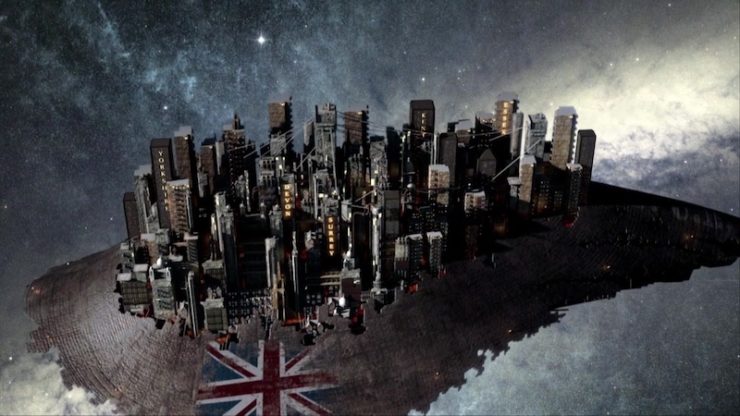
The fifth season episode “The Beast Below”, saw the Doctor and Amy on their first proper adventure, forward into the future to a ship known as Starship UK. In the 29th century the Earth was threatened by solar flares, but the entirety of the United Kingdom (minus Scotland, who wanted their own ship) could not manage to make an escape to space. A star whale appeared, and the humans captured it and built their ship around the whale. Never expecting that the endangered whale was offering assistance freely, humans needlessly tortured the star whale for generations as the ship’s engine, with every human adult getting to vote on the whale’s continued enslavement and then electing to “forget” their knowledge until the next vote. Once Amy and the Doctor figured out what was going on, the Doctor considered lobotomizing the whale so it would no longer feel pain, but Amy figured out that the star whale came to help and released it by pressing the “abdicate” button on the queen’s vote console. The whale stayed with the ship, the continued custodian of Starship UK.
Olympia — Medusa in the Graveyard by Emily Devenport
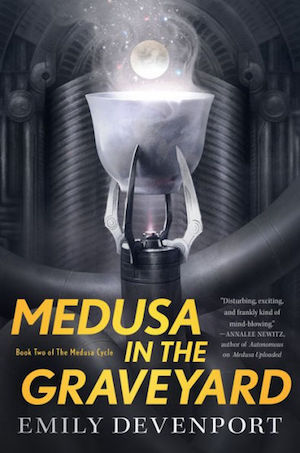
Is there a better setting for a locked-room murder thriller than a generation ship? There’s nowhere to escape to except SPACE, so any assassin’s targets are pretty doomed. But in the case of Medusa Uploaded, you’re definitely going to root for the assassin. Oichi Angelis is a servant on the Olympia. The Olympia’s sister ship, the Titania, exploded with her low-key revolutionary parents aboard, so she was already starting to research the cruelly elitist class policies the Executives force on the resto f the ship. But when one of the Executives jettisons her into space, things get even more personal. Luckily Oichi is rescued by a sentient AI called Medusa, who assists her in her plot to assassinate the Executives…and now that everyone thinks she’s dead, getting up to murder will be considerably easier.
In Book Two of The Medusa Cycle, Medusa in the Graveyard, the Olympia continues its voyage into the not-ominous-at-all Charon system. Because now a delegation has to take the most terrifying step a generation shipper can make: they’ll have to leave the ship. What will it be, for people whose entire lives have been bounded by the walls of their vessel, to touch solid ground?
The Ark — The 100
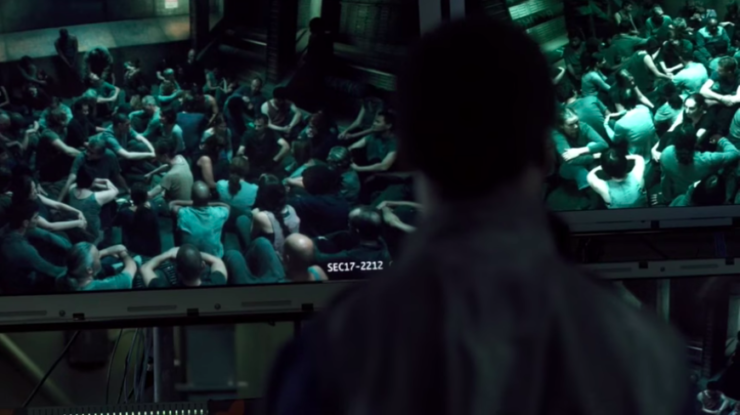
The Ark is the epitome of someone who thinks they want to be in a relationship but doesn’t actually want to put in the work. When humanity escaped the nuclear apocalypse in 2052, it was in a baker’s dozen of separate space stations launched from the United States, the UK, France, Russia, Japan, India, Uganda, and other nations. After a few years of floating past one another, they started to get lonely, which led to fusing a dozen stations (minus rebel Polaris) into one Ark.
Despite whatever good intentions brought everyone together, the Ark managed to be a hot mess for its entire first century of existence. The population ballooned from 400 to 2,400, which severely hampered life support systems. In turn, the governing bodies who ran the Ark had to start instituting population-culling measures including a one-child policy, the punishment of “floating” for treasonous crimes, cutting the oxygen from entire swaths so the rest of the station could breathe a little longer (RIP Section 17), and, oh yeah, sending 100 juvenile delinquents down to irradiated Earth, effectively to their deaths.
This was a case of stronger apart than together, so by the time the parents on the Ark decided to take their chances with their kids on Earth and broke the Ark back into its components—which they then crash-landed on the planet’s surface—it was a long time coming.
LDSS Nauvoo — The Expanse
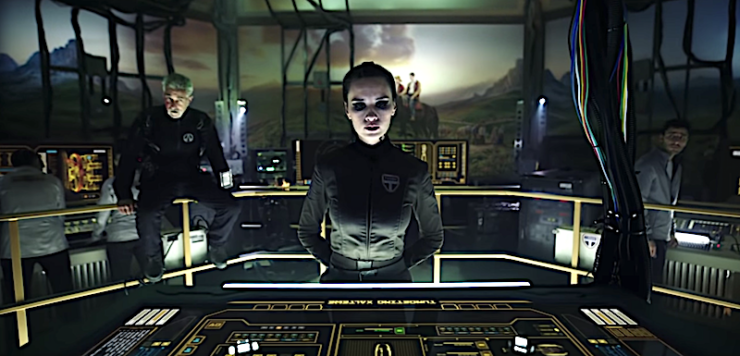
In the world of The Expanse, humanity has spread out across the solar system, and stratified into a system of elitist “Earthers” (who are seen as spoiled brats by all the non-Earthers), Mars colonists (who are tough and hardened from their years of trying to terraform the Red Planet), and Belters (a disenfranchised working class who live on the asteroid belt mining ice and cultivating a vibrant black market). But there’s another group, one who tries to harvest members of all three tiers, and that group is the Mormons. The Mormons have thrived in the future, boasting large numbers, and they have a plan to go on a mission trip toward Tau Ceti, a solar system 12 light-years away that might support life. Knowing that this will be a generations-long journey, the Mormons buy and outfit a gargantuan ship, the LDSS Nauvoo—2,460 meters long, 950 meters wide, and 910 meters deep—with ten levels of civilization including schools, machine shops, gardens, and, a massive room decorated with murals of the Mormon expedition to Salt Lake back on Earth.
Alas, the Nauvoo never gets to go on her mission: She’s repurposed in a desperate attempt to save humanity from an alien threat, and then finds new life as the Behemoth, a battleship for the Outer Planets Alliance.
The Matilda — An Unkindness of Ghosts by Rivers Solomon

At the start of Rivers Solomon’s debut novel, it has been over 300 years since the Matilda launched from the Great Lifehouse—an uninhabitable Earth. In the course of its journey to a near-mythical Promised Land, this vast generation ship has structured itself after the antebellum South: Its inhabitants are segregated according to skin color, with the darker-skinned people forced to labor in the lower decks—one for every letter in the alphabet—so that the white upper-deckers can enjoy well-lit, temperature-controlled, luxury-filled mansions without worrying about blackouts or malnutrition. What’s more, the omnipotent Sovereignty regularly abuses the lower-deckers, blaming their supposed “sins” for keeping the Matilda from its destination. With no protections, and with limited access even to the decks above and below them, those living in the slums know little else beyond their own dialects and customs; it is, as protagonist Aster Grey notes, the closest thing to a nationality.
Due to her status as a doctor, and her mentorship from the powerful Surgeon General, Aster is allowed to move between decks, all the more for her to witness the racist and brutal disparities among the Matilda’s population. But when a discovery in her late mother’s journals draws comparisons to the mysterious death of the Sovereign, Aster has the chance to learn more about Matilda’s inner workings, its power source, and whether there is actually an existence beyond the ship.
Command Carriers — Farscape
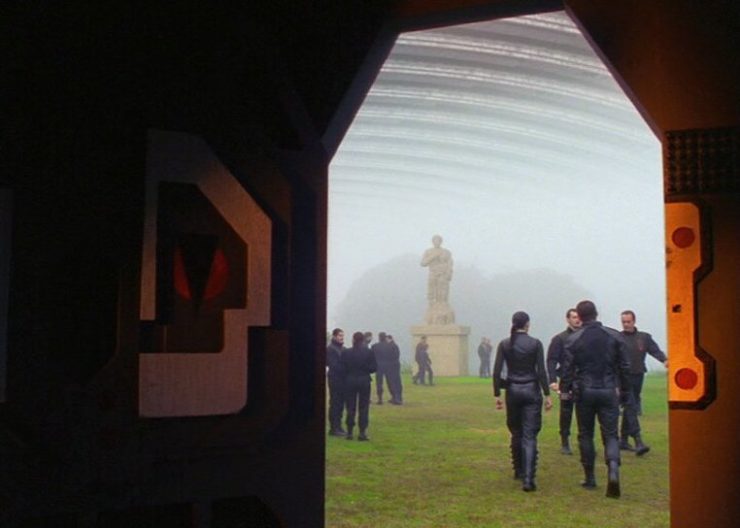
In the Farscape universe, the term Peacekeeper seems to be a misnomer—all Sebaceans born into the Peacekeeper way of life exist to be soldiers, members of a galactic super-armada that claims to bring peace… but can only manage to do so with war and weaponry. Their command carriers are giant ships that serve as the centers of Peacekeeper fleets. They are filled with crew of 50,000, who work and live on the carriers, even having children who are born and raised there. Training areas on command carriers can resemble planetary conditions with sky, grass and trees, and more organic-seeming terrain. Essentially, a Peacekeeper could live their entire life on the same command carrier if their duties kept them on board. They do require refueling and other maintenance, but command carriers are well suited to the task of housing tens of thousands of individuals, keeping sizable portions of the Peacekeepers fighting forces in motion and at the ready.
Lsel Station — A Memory Called Empire and A Desolation Called Peace by Arkady Martine

On the fringes of Teixcalaanli space spins a small independent mining station carrying 30,000 souls. Well, 30,000 bodies and about ten times as many souls, thanks to Lsel Station’s long tradition of imagos. Each stationer, upon being assigned their roles as miners, pilots, heritage, and especially the councilors of these departments, is also given an imago-machine: a neurological implant containing the memory-lines of their predecessors. Depending on the job, experience, and imago maintenance, a given imago could stretch back just a few generations, or perhaps a dozen and more. The most optimal imago situations involve the recipient stitching their mind to the memory-line, so that they become a combination of themselves but also their predecessor, who was in turn an assimilation of themselves and the memories who came before.
While the use of imagos are commonplace on Lsel, the practice is highly guarded outside of the station, as its inhabitants realize how barbaric or simply alien the practice might appear to those who go through life with only one consciousness. After all, how could you understand the benefits of experience if you hadn’t been raised with the expectation that your mind and personality would blend with those of your ancestors?
Yonada — Star Trek
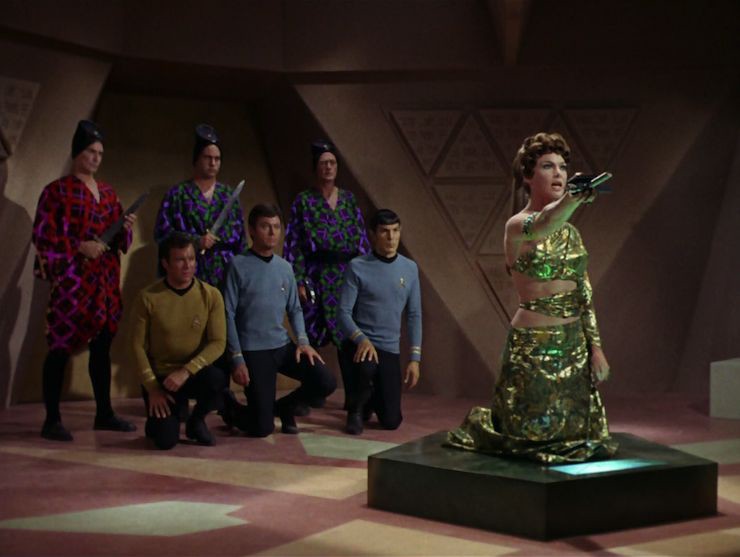
In the third season Original Series episode “For the World is Hollow and I Have Touched the Sky”, the Enterprise has to stop an asteroid that is about to collide with a Federation planet called Daran V. It turns out that said asteroid is actually a ship disguised to look like an asteroid, leading Kirk, Spock, and McCoy to beam aboard and figure out what’s going on. They meet a High Priestess named Natira who calls the ship the “world of Yonada”, a place where they get all of their directions from a mysterious “Oracle” who gives devastating electric shocks to people who disobey its commands. Spock eventually figures out that the Yonadans are descended of the Fabrini, a race that was thought to have died out over ten thousand years ago by a supernova. The Yonadans don’t have any idea about their past, and they don’t know that their world is actually a ship traveling through space. (There’s a whole side plot here where McCoy gets an incurable disease, gets married to Natira, and eventually gets a magical cure for his disease thanks to the Frabini archives, but that’s all pretty much a wash by the end of the episode…) Eventually, Spock finds the control room to this mechanized Oracle and fixes the ship so that it can set the Yonadans down on their own habitable world, but the setup of their ship had many of the denizens fooled for millennia.
Godspeed — Across the Universe by Beth Revis
Amy volunteers to be cryogenically frozen on Sol-Earth in order to wake up on Centauri-Earth, but when she unexpectedly gets thawed, she learns that she has been revived fifty years too early—and there’s no way to put her back in stasis. But even though her unfreezing was half a century ahead of schedule, generation ship Godspeed has nonetheless changed drastically since its first crew lifted off from Earth. The entire population is monoethnic and separated across strict cultural lines according to purpose: the Shippers keep Godspeed running; the Feeders supposedly maintain the ship’s vegetation, but during the Season, they go into a mating frenzy; and the Keepers—that is, the leader Eldest and his protege, Elder—oversee everything. As Amy tries to find out who is unplugging cryo pods and murdering their inhabitants, she unwittingly brings to light the various ways in which past Eldests have kept Godspeed on track.
Originally published July 2019.












“The Stars Are Legion” by Kameron Hurley.
In Jo Walton’s story, Turnabout, the people on a generation ship heading for a new planet are starting to think that ship-based life has its advantages.
I noted that this article was originally published in 2019. I checked out those comments and saw that plenty of people already mentioned Gene Wolfe’s ‘Book of the Long Sun’ and Kim Stanley Robinson’s ‘Aurora’ so I won’t rehash those. Instead, I’ll mention SEVENEVES. A number of people seemed not to care for the last third of that novel and the abrupt shift away from the space-station story and characters. I thought it was brilliant and a very interesting take on how humanity might actively recreate itself after several generations spent in a chain of habitats orbiting a depopulated Earth. Lots of still-untapped story potential in that book. I’d actually be happy if Stephenson followed up with a sequel.
Starship by Brian Aldiss. The Great Ship series from Robert Reed.
Was hoping the Turian Fleet from Mass Effect would make an appearance but happy to see the space whale again, though.
David Brin and Gregory Benford’s 76 year expedition in Heart Of The Comet is an interesting case as well.
Keeping with Doctor Who, I’d like to submit the generation ship trapped by a black hole so that time runs faster at one end of it than the other in World Enough And Time/ The Doctor Falls by Steven Moffat.
The Free Traders—not the smuggling kind—Thorby joins in Citizen of the Galaxy.
I read Kim Stanley Robinson’s Aurora and thought it was interesting enough that I picked up his next, New York 2140 and the number of grotesque scientific inaccuracies left my jaw dangling. In the end, I could not even finish the novel because it angered me so. Kids diving for treasure on a homemade rig in the East River? Then hostages held underwater in a shipping container provisioned by way of a descending inflatable stairway? If Robinson had so much as sat through a two-day intro to scuba class at his local YMCA, he would have thrown half his first draft into the trash. In the light of such sloppiness, I downgraded my opinion of Aurora. Would never touch another KSR novel again.
Farscape carriers are like cute little technologically challenged GSVs.
I’m a little surprised the author hasn’t included The Culture in this article.
Knights of Sidonia
For those of you who can read German and know the longest-running and largest SF print series in the world “Perry Rhodan”, the SOL comes to mind. Originally meant as a huge military ship, unplanned it had at its start to take on thousands of civilians, including whole families, which over time (and with new generations born on board) see the ship as their home. This automatically lead to conflict when the hero constantly get this home into danger of being blown up in countless dangerous situations. At some point, command of the SOL goes over to the SOL-born who try to get away from galactic conflict and do their own thing (spoiler: I did not work).
The SOL shows up first in the series in volume 700 (written in 1975) and is still active (modified, repaired, partially replaced) today, over 2000 years in-series time later.
@9 : Yep, I really though The Culture would be in here too. Possibly Arbitrary from The State of the Art as a concrete example both of the society and what those ships can do.
Heinlein: Orphans of the Sky—old-school generation ship
Blish: Cities in Flight–don’t just build spaceships, turn Pittsburgh, New York, and Scranton into spaceships! Also the Free Planet of He, an entire planet outfitted with spacedrive. Talk about staycations!
Obligatory and inevitable mention of The Starlost. Read the novel (Phoenix without Ashes, by Harlan Ellison) or the comic, but only attempt the television series with several Vesper martinis to hand (because one should always have a Vesper martini to hand).
@@.-@ The original British edition title for Aldiss’s “Starship” was “Non-Stop,” which has the virtue of ACTUALLY NOT SPOILING THE ENDING BY GIVING IT AWAY ON THE FRONT COVER.
The Warhammer 40k ‘verse features the Chartists, massive cargo passenger ships with their own weird cultures. Being 40k those cultures get very weird!
@@@@@ 16, princessroxana:
The Warhammer 40k ‘verse features the Chartists, massive cargo passenger ships with their own weird cultures. Being 40k those cultures get very weird!
Did any of those cultures resemble England’s 19th century chartists?
No. Completely different things.
The Babyolon 5 space station on Babylon 5
And then becomes Medina Station, in the centre of the ring gates, and is variously retrofitted and fought over/in by various factions.
Stephen Baxter’s Ark is great for a generation ship whose inhabitants very quickly screw it all up.
Becky Chambers’ Record of a Spaceborn Few has an entire fleet of more-or-less permanently space-based humans busy making a culture together. Lee and Miller’s Liaden Universe has Terran trading families permanently based on their ships as they fly carefully-designed loops, stopping at various planets and stations to trade in an endless cycle (until the Universe changes and stirs up Plot).